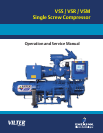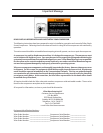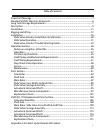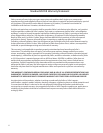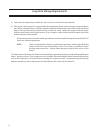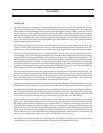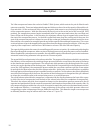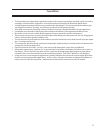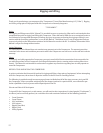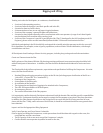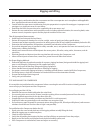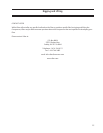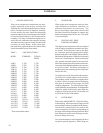
9
COMPRESSOR
The Vilter Single Screw Compressor is a positive displacement, capacity and volume controlled, oil ooded,
rotary compressor which uses a single main screw intermeshed by two opposing gate rotors. Gas compression
occurs when the individual ngers of each gate rotor sweep through the grooves, or utes, of the main screw as
the screw rotates. Compression occurs from the time the screw ute is rst closed off by the gate rotor nger,
until the time when the screw ute has rotated to the point of lining up with the discharge port in the compres-
sor housing. A labyrinth type seal is used to prevent gas at discharge pressure from leaking past the end of the
screw. Any discharge gas leakage past the labyrinth seal is vented back to suction via four longitudinal holes
drilled through the body of the screw.
By venting the discharge end of the main screw back to suction, forces on each end of the screw are equal. This
results in zero net axial forces on the main bearings. With twin opposing gate rotors, all radial forces are can-
celled out also. Main shaft bearings have no net forces except the weight of the screw and the shaft assembly.
The compressors are comprised of three rotating assemblies: the main screw assembly and the two gate ro-
tor assemblies. Each of these rotating assemblies use a common bearing conguration consisting of a single,
cylindrical rolling element bearing at one end, and a pair of angular contact ball bearings at the other end. The
pair of angular contact ball bearings are used to axially x one end of the rotating shafts, and to absorb the small
amount of thrust loads on the shafts. The inner races of the ball bearings are securely clamped to the rotating
shafts, while the outer races are securely held in the bearing housing, thus xing the axial position of the shaft
in relation to the bearing housings. The cylindrical roller bearings at the opposite end of the shafts allow for
axial growth of the shafts while supporting the radial loads from the shafts.
The suction gas enters the compressor housing through the top inlet ange, at the driven end of the unit. The
driven end of the compressor housing is ooded with gas at suction pressure. The gas enters the open end of
the main screw utes at the driven end, and becomes trapped in the screw ute as the screw rotates and the
gate rotor tooth enters the end of the ute. At this point, the compression process begins. Directly after the
screw ute is closed off by the gate rotor tooth, oil is injected into the groove.
The oil enters the compressor through a connection at the top of the compressor. The purpose of the injected oil
is to absorb the heat of compression, to seal the gate rotor tooth in the groove, and to lubricate the moving parts.
Additional internal oiling ports are provided at the main and gate rotor bearings to cool and lubricate the bear-
ings. The mechanical shaft seal housing also contains oiling ports to lubricate, cool and provide a sealing lm
of oil for the mechanical shafts seal. Excess oil ows through the check valves on the sealing bafe plate. This
oil is directed at the main rotor roller bearing, which cools and lubricates the front roller bearing.
As the main screw rotates, the gate rotor is also driven, causing the gate rotor tooth to sweep the groove in the
main screw. This sweeping action reduces the volume of the groove ahead of the gate rotor tooth and causes
the trapped gas and oil to be compressed in the reduced volume. As the main screw continues to rotate, the
gate rotor tooth continues to reduce the groove volume to a minimum, thus compressing the trapped gas to
a maximum pressure. A labyrinth seal arrangement prevents the compressed gas from leaking past the end of
the screw. As the gate rotor tooth reaches the end of the groove, the groove rotates to a position that lines up
with the discharge port in the compressor housing and the gas/oil mixture is discharged from the screw at high
pressure. This completes the compression cycle for a single ute of the main screw.
Once the gas is swept from the main screw ute through the discharge port, it passes into the discharge manifold
of the compressor. From the discharge manifold, the gas/oil exits the compressor housing
Description



